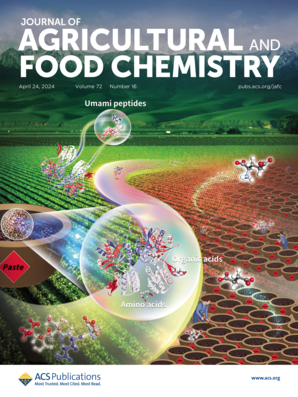自噬中的封存体1调控条纹茎螟虫对Cry9Aa蛋白的防御反应
IF 6.2
1区 农林科学
Q1 AGRICULTURE, MULTIDISCIPLINARY
引用次数: 0
摘要
苏云金芽孢杆菌产生杀虫晶体(Cry)蛋白,靶向并破坏害虫中肠上皮细胞,最终导致幼虫死亡。然而,暴露于亚致死浓度的Cry蛋白可以激活防御反应来抵消毒性。本研究通过电镜检测自噬体,Western blot分析Atg8- pe /Atg8比值,以及Atg8- pe斑点的可视化,揭示了抑制螟幼虫中肠对亚致死剂量Cry9Aa的中度自噬反应。此外,差异基因表达分析显示,自噬受体基因sequestosome 1 (sqstm1)和atg12显著上调,支持自噬在Cry9Aa中毒反应中的潜在作用。敲除sqstm1使幼虫对Cry9Aa的易感性增加了30%,突出了其在防御中的作用,而敲除atg12仅使易感性增加了8%。我们的研究结果表明,sqstm1通过一种机制反应参与了C. suppressalis对Cry9Aa中毒的防御,这种机制反应可能并不严格依赖于典型自噬。本文章由计算机程序翻译,如有差异,请以英文原文为准。

Sequestosome 1 in Autophagy Regulates a Defense Response of the Striped Stem Borer to the Cry9Aa Protein
Bacillus thuringiensis produces insecticidal crystal (Cry) proteins that target and destroy insect pest midgut epithelial cells, ultimately leading to larval death. However, exposure to sublethal concentrations of Cry proteins can activate defense responses to counteract toxicity. Here, we revealed a moderate autophagy response to a sublethal dose of Cry9Aa in the larval midgut of Chilo suppressalis through autophagosome detection by electron microscopy, Western blot analysis of the Atg8-PE/Atg8 ratio, and visualization of Atg8-PE puncta. Additionally, differential gene expression analysis showed significant upregulation of the autophagy receptor genes sequestosome 1 (sqstm1) and atg12, supporting a potential role for autophagy in the response to Cry9Aa intoxication. Knocking down sqstm1 increased larval susceptibility to Cry9Aa by 30%, highlighting its role in defense, whereas atg12 knockdown increased susceptibility by only 8%. Our findings suggest that sqstm1 contributes to C. suppressalis defense against Cry9Aa intoxication through a mechanism response that may not be strictly dependent on canonical autophagy.
求助全文
通过发布文献求助,成功后即可免费获取论文全文。
去求助
来源期刊
CiteScore
9.90
自引率
8.20%
发文量
1375
审稿时长
2.3 months
期刊介绍:
The Journal of Agricultural and Food Chemistry publishes high-quality, cutting edge original research representing complete studies and research advances dealing with the chemistry and biochemistry of agriculture and food. The Journal also encourages papers with chemistry and/or biochemistry as a major component combined with biological/sensory/nutritional/toxicological evaluation related to agriculture and/or food.

 求助内容:
求助内容: 应助结果提醒方式:
应助结果提醒方式:


